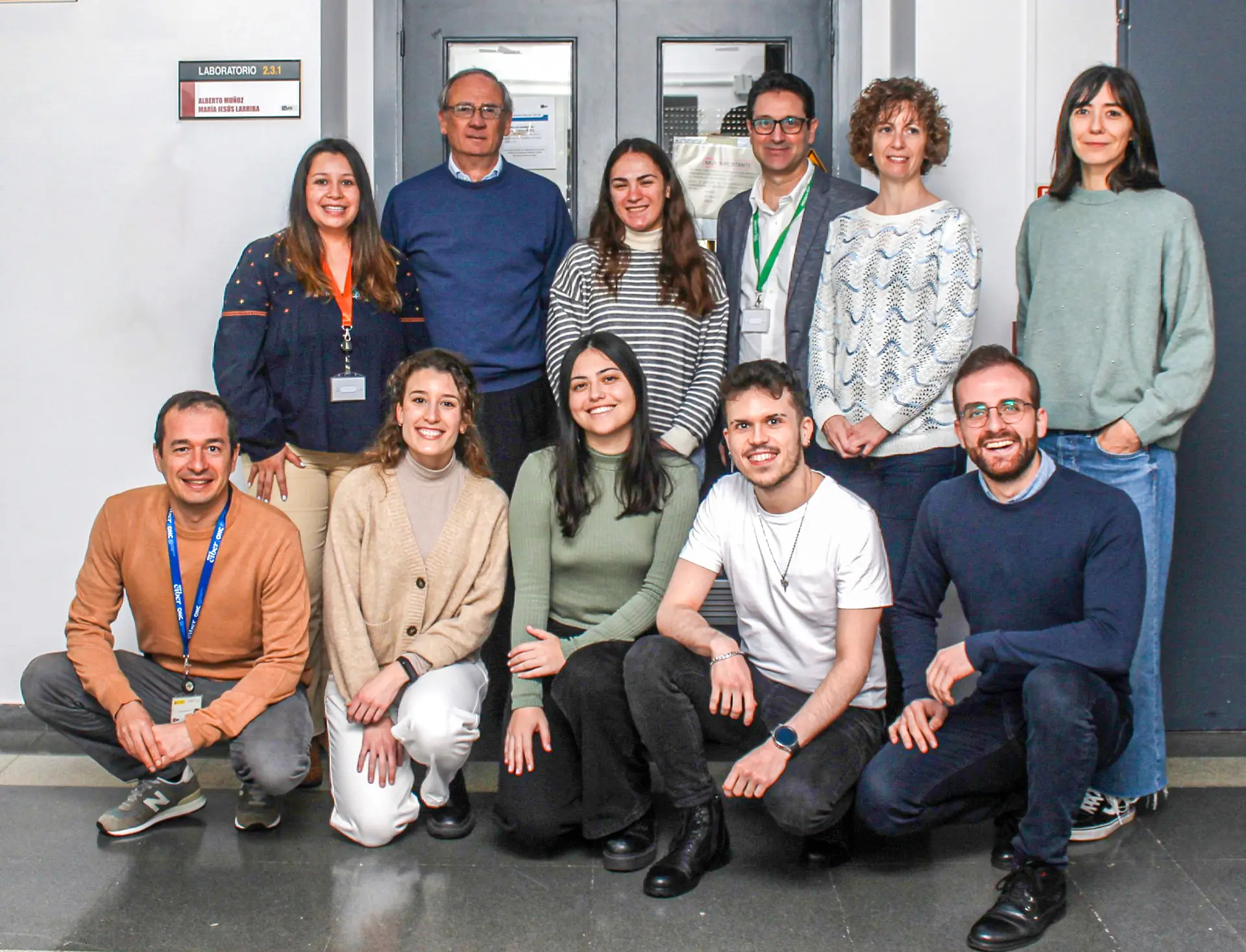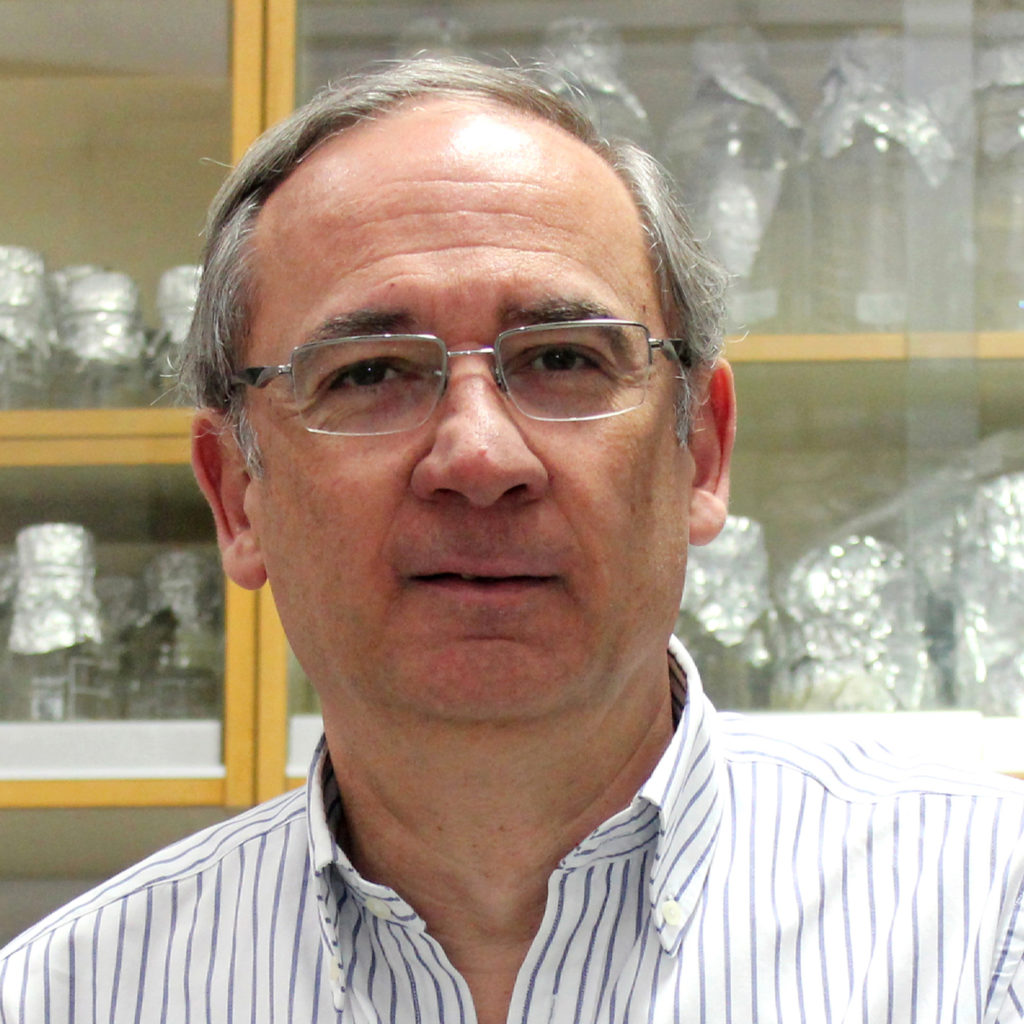Dc. Muñoz Group
Vitamin D and Colon Cancer
Alberto Muñoz is Research Professor at the Instituto de Investigaciones Biomédicas Alberto Sols (IIBM, Madrid), Spanish National Research Council (CSIC). He received his PhD in Sciences at the Universidad Autónoma de Madrid (1983). He worked at Antibióticos S.A. (Madrid, 1984-86) on the mechanism of action of interferon and interleukin-2. Later, he joined B. Vennström’s group at the European Molecular Biology Laboratory (Heidelberg, 1986-88) to study the biology of the erbA oncogene, contributing to the characterization of the c-erbA protein as the high affinity thyroid hormone receptor (TR). Then, he moved to H. Beug’s lab at the Institut für Molekulare Pathologie (Genentech-Boehringer Ingelheim, Vienna, 1990-91) to continue working on TR/c-erbA and v-erbA genes. Back to Madrid, he started his own group at the IIBM and conducted studies on the gene regulatory effects of thyroid hormone and TR in the brain and the mammary gland, and on the antagonism of AP-1 transcription factor by glucocorticoids/GR. Since 1999, his laboratory is focused on the action of vitamin D3 and its receptor (VDR) in human colorectal cancer (CRC): identification and study of target genes, regulation of VDR expression, effects on cell phenotype and interference of the Wnt/β-catenin pathway. Nowadays, his group studies vitamin D3/VDR action on human colon normal and cancer stem cells establishing organoids from CRC patients, and on patient-derived colon normal and cancer-associated fibroblasts.


About Us
- Principal Researchers:
Alberto Muñoz Terol
María Jesús Larriba Muñoz
José Manuel González Sancho - Postdoctoral Researchers:
Antonio Barbáchano Becerril
Asunción Fernández Barral
Pilar Bustamante Madrid
Arturo González de la Aleja Molina - Predoctoral Researchers:
David Albandea Rodríguez
Silvia Rodríguez Marrero - Lab manager:
Johanna Troya Balseca

What Do We Research?
CRC is the most frequent neoplasia in Spain and a major health problem worldwide. Despite the advances during the last decades, there are no satisfactory therapeutic options for CRC patients when surgery is not curative. Many epidemiological studies associate vitamin D3 deficiency with multiple diseases including bone-related abnormalities (rickets and osteomalacia), neurological and immune/inflammatory disorders and several cancers. According to the World Health Organization, CRC is the neoplasia that is most clearly associated with vitamin D3 deficiency in terms of incidence and mortality. The causal link is probable but not fully demonstrated. Extensive experimental studies in vitro and in animal models support a protective action of vitamin D3 and its most active metabolite 1,25-dihydroxyvitamin D3 (calcitriol) against CRC. Work by our group and others has shown that calcitriol inhibits colon carcinoma cell proliferation, migration, and invasion, while it promotes their epithelial differentiation, in part through the inhibition of the Wnt/-catenin pathway that is aberrantly activated in most colon tumors. In addition, calcitriol has a panel of anti-angiogenic and immunomodulatory actions. However, the results of the clinical trials that test the action of vitamin D3 supplementation in CRC are controversial and have not confirmed a protective action, which may be at least partly due to deficient design (insufficient duration, bad selection of patients, low doses, false placebos, etc…).
Human VDR gene locates at chromosome 12q.13.11 and encodes VDR protein, the unique high affinity calcitriol receptor, which belongs to the nuclear receptor superfamily (NR1I1). Calcitriol is a major regulator of the human genome through its binding to and regulation of VDR. The gut is a major target tissue of vitamin D3. Calcitriol is crucial for intestinal calcium and phosphate absorption, epithelial barrier function, protection against infection, and detoxification. In line with this, VDR is expressed at a high level in the intestine by epithelial and non-epithelial (fibroblasts, B- and T-lymphocytes and macrophages) cells. Both VDR RNA splicing variants and VDR protein posttraslational modifications (acetylation, phosphorylation) have been reported. VDR localizes predominantly within the cell nucleus, while a variable cell type-dependent minor proportion resides in the cytosol and possibly also transiently at the plasma membrane. VDR mediates the genomic (modulation of the transcription rates of hundreds of cell-specific target genes) and non-genomic (extracellular Ca2+ entry to the cytosol, regulation of cytosolic enzymes) effects of calcitriol. The expression of VDR is induced by calcitriol transcriptionally and/or posttranscriptionally depending on the cell type, and is also modulated by several microRNAs that control the stability/translation of its mRNA. Moreover, our group described for the first time that the transcription factors and major inducers of epithelial-to-mesenchymal transition SNAIL1 and SNAIL2/SLUG bind to the VDR gene promoter and are potent repressors of its expression. Thus, SNAIL1 and SNAlL2/SLUG expression in colon carcinoma cells (and other cell types) causes resistance to calcitriol action. Studies in cultured cells and experimental animals have also shown that VDR mediates the key role of the epigenetic modulator KDM6B in calcitriol gene regulatory effects and the antagonism of the Wnt/-catenin pathway by calcitriol.
In recent years, we have successfully generated a large living biobank (more than 100 CRC patients subjected to surgery) of human colon organoids from healthy and tumor tissue biopsies. We have learnt that calcitriol has a widely distinct effect in both types of patient-derived organoids: it induces the expression of stemness genes and maintains the undifferentiated cell phenotype in normal organoids, while it promotes partial cell differentiation in tumor organoids. Calcitriol reduces cell proliferation in both types of organoids. Remarkably, organoids have promising applications for drug screening as they allow precision/personalized medicine studies. Thus, we have also developed a robust cytotoxicity assay for normal and tumor organoids in order to test chemotherapeutic drugs alone or in combination with calcitriol. Currently, we are setting up the protocols to induce the differentiation of human colon stem cells present in healthy tissue-derived organoids, which will allow us to investigate the effects of calcitriol. We have also generated a large biobank of primary cultures of normal and tumor-associated fibroblasts established from fresh surgical biopsies of CRC patients. Both cell types express VDR and calcitriol inhibits their capacity to paracrinally induce the migration of colon carcinoma cells. Accordingly, high expression of VDR and of a calcitriol-associated gene signature in tumor stromal fibroblasts is associated with longer survival of CRC patients. Ongoing studies include the analysis of calcitriol/VDR action on the metabolism of colon normal and cancer stem cells and fibroblasts, its interaction with some of the relevant CRC mutations, and its paracrine effects on other cells of the tumor microenvironment.
Publications
- Vitamin D opposes multilineage cell differentiation induced by Notch inhibition and BMP4 pathway activation in human colon organoids
Bustamante-Madrid P., Barbáchano A., Albandea-Rodríguez D., Rodríguez-Cobos J., Rodríguez-Salas N., Prieto I., Burgos A., Martínez de Villarreal J., Real F.X., González-Sancho J.M., Larriba M.J., Lafarga M., Muñoz A., Fernández-Barral A.Cell Death Dis. 2024, en prensa.
- From molecular basis to clinical insights: a challenging future for the vitamin D endocrine system in colorectal cancer
Pereira F., Fernández-Barral A., Larriba M.J., Barbáchano A., González-Sancho J.M.FEBS J. 2023 Sep 12. doi: 10.1111/febs.16955. Online ahead of print.
- Vitamin D induces SIRT1 activation through K610 deacetylation in colon cancer
García-Martínez J.M., Chocarro-Calvo A., Martínez-Useros J., Fernández-Aceñero M.J., Fiuza M.C., Cáceres-Rentero J., De la Vieja A., Barbáchano A., Muñoz A., Larriba M.J., García-Jiménez C.Elife. 2023 Aug 2;12:RP86913.
- An update on vitamin D signaling and cancer
Carlberg C, Muñoz A,Semin Cancer Biol. 2022 Feb;79:217-230.
- Vitamin D differentially regulates colon stem cells in patient-derived normal and tumor organoids
Fernández-Barral A., Costales-Carrera A., Buira S.P., Jung P., Ferrer-Mayorga G., Larriba M.J., Bustamante-Madrid P., Domínguez O., Real F.X., Guerra-Pastrián L., Lafarga M., García-Olmo D., Cantero R., Del Peso L., Batlle E., Rojo F., Muñoz A., Barbáchano A.FEBS J. 2020 Jan;287(1):53-72.
- Vitamin D and Wnt3A have additive and partially overlapping modulatory effects on gene expression and phenotype in human colon fibroblasts
Ferrer-Mayorga G., Niell N., Cantero R., González-Sancho J.M., Del Peso L., Muñoz A., Larriba M.J.Sci Rep. 2019 May 30;9(1):8085
- Vitamin D receptor expression and associated gene signature in tumour stromal fibroblasts predict clinical outcome in colorectal cancer
Ferrer-Mayorga G., Gómez-López G., Barbáchano A., Fernández-Barral A., Peña C., Pisano D.G., Cantero R., Rojo F., Muñoz A., Larriba M.J.Gut. 2017 Aug;66(8):1449-1462
- MicroRNA-22 is induced by vitamin D and contributes to its antiproliferative, antimigratory and gene regulatory effects in colon cancer cells
Alvarez-Díaz S., Valle N., Ferrer-Mayorga G., Lombardía L., Herrera M., Domínguez O., Segura M.F., Bonilla F., Hernando E., Muñoz A.Hum Mol Genet. 2012 May 15;21(10):2157-65
- Cystatin D is a candidate tumor suppressor gene induced by vitamin D in human colon cancer cells
Alvarez-Díaz S., Valle N., García J.M., Peña C., Freije J.M., Quesada V., Astudillo A., Bonilla F., López-Otín C., Muñoz A.J Clin Invest. 2009 Aug;119(8):2343-58
- The transcription factor SNAIL represses vitamin D receptor expression and responsiveness in human colon cancer
Pálmer H.G., Larriba M.J., García J.M., Ordóñez-Morán P., Peña C., Peiró S., Puig I., Rodríguez R., de la Fuente R., Bernad A., Pollán M., Bonilla F., Gamallo C., de Herreros A.G., Muñoz A.Nat Med. 2004 Sep;10(9):917-9




